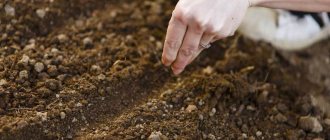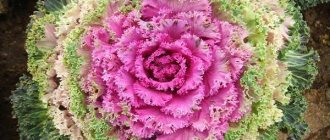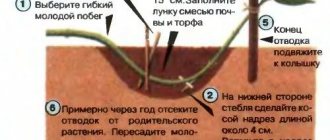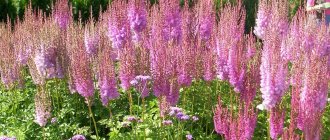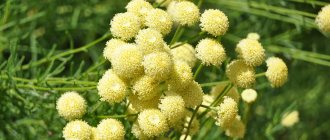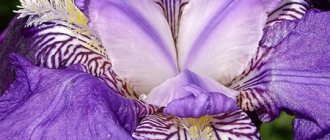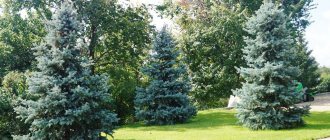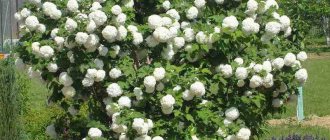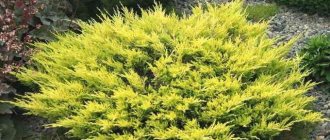What is irga, photo, description
Irga is an unpretentious ornamental shrub of the rose family that produces a bountiful harvest of healthy, very tasty berries. Depending on the variety, it can be a spreading bush or a tree.
Its homeland is North America, where the bush can be found on the forest edge or in the mountains. In the 17th - 18th centuries, serviceberry became widespread in Europe, where it was used as a decorative park crop. Under natural conditions it is found in the Crimea and the Caucasus.
Large-fruited shadberry is best suited for a garden plot; growing varietal bushes is not a difficult matter. Flowering depends on the region : in the north of the Krasnodar Territory - late April and early May; in the Moscow region - in early June.
The serviceberry harvest begins in July and continues until early September.
Pests and diseases
The plant's resistance to many diseases is good. Sometimes a culture may suffer from diseases such as:
Tubercularosis - the disease can be identified by the leaves turning brown, which gradually begin to fall off. Red bumps appear on the branches.
When the first signs of the disease appear, you must immediately remove the affected parts of the plant. Also treat the bush or tree with copper sulfate or Bordeaux mixture.
Phyllostictosis spotting - with it, the leaves wilt, on which brown spots appear. The affected leaves need to be collected and burned, and the bush should be treated with Bordeaux mixture.
Gray rot - this disease can be identified by yellowing leaves, they become moldy and fall off. Treatment is carried out with the same Bordeaux mixture.
The most common pest is the shadberry seed beetle. It penetrates the fruit and eats all the seeds. Treating the plant with karbofos will help get rid of pests.
What is attractive about growing irgi in the country?
Why is it worth growing irgu on your site?
- This is an excellent honey plant that attracts bees to pollinate the garden.
- Delicious, very healthy berries will appeal to the whole family.
- Another plus is the decorative effect throughout the season and the bright purple color of the serviceberry bushes in the fall. Lush blooms in the spring, followed by abundant pink beads of berries, gradually changing their color to a wine shade. By autumn, the clusters will turn purple, they will look great against the background of reddened foliage.
Choosing a variety of serviceberry, planting and breeding on the site
In nature, there are more than 20 species of shrub serviceberry (Amelanchier), and about ten cultivated varieties are used in gardening. In the Moscow region, the most common species is the large-leafed shadberry, the spicate game. These are practically natural species, not capricious, resistant to frost and drought.
Their disadvantage is the lush basal growth, which tends to take up more and more space. For a new planting, it is worth choosing a varietal plant; there will be an order of magnitude fewer problems with shoots. We can recommend the large-fruited Canadian shadberry.
High-yielding new varieties of serviceberry are very interesting :
northline; Krasnoyarsk; ballerina; Thyssen. Simple species reproduce easily; new plants hatch even from fallen berries.
Reproduction of modern varieties of serviceberry is carried out only by vegetative means - by dividing a young bush, by root shoots or cuttings. There is an interesting way to propagate serviceberry by grafting varietal cuttings onto rowan trees. The method is troublesome, but allows you to curb root growth.
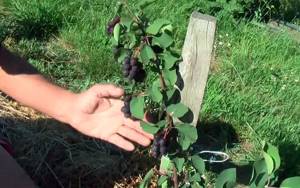
Types and varieties of plants
The serviceberry bush is often grown to attract insects, as it is considered an excellent honey plant.
The plant also produces berries, which both adults and children would not mind eating. In England it is called "Juneberry".
This is due to the harvest time, which occurs towards the end of June.
In our country, spring and summer are cold, so the ripening of berries may be delayed until July or even August.
Today there are approximately 25 types of culture.
Gardeners grow only some of them, since not all varieties produce a high-quality harvest.
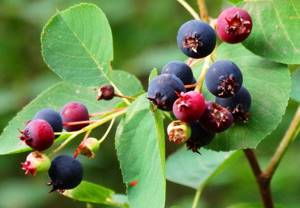
Irga Ordinary It is a berry shrub up to 3 m high. Irga Ordinary has an erect trunk with spreading branches and shoots. This species grows for about 10-15 years.
The plant has flexible, thin shoots. There are very few leaves on the main branches, mostly located on young branches.
The second name of the species is Irga Large-leaved.
They called it that because of the impressive size of the leaves. The leaves of the common serviceberry are oval and pointed at the edges.
Young foliage has a whitish tint that fades to green over time. With the arrival of autumn, the foliage turns orange-red.
Common serviceberry flowers are white with a delicate pink tint. Their diameter reaches 3 cm. During flowering, the shrub looks magical and snow-white.
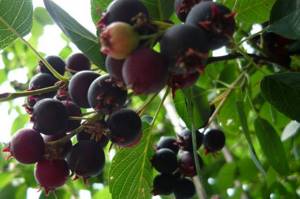
Irga Spica Decorative Irga Spica is a tree or bush with snow-white or pinkish inflorescences. The species is resistant to many diseases. Pests also rarely attack the plant.
Another positive point when growing this particular species is its frost resistance. Saskatoon berries contain a lot of sugar, but their taste is rather mediocre.
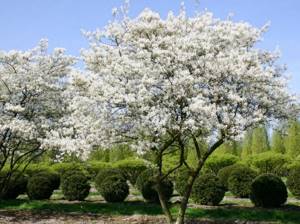
Irga Lamarca Tall deciduous shrub up to 5 m in height. The crown of a tree or shrub forms powerful skeletal shoots. The crown is shaped like an umbrella. The leaves of Lamarck's serviceberry are elongated and somewhat pointed at the edges. The length of the leaflets can be from 4 to 9 cm, width - from 2 to 5 cm.
When new leaves grow, it has a coppery-purple hue. Over time, the foliage turns dark green.
With the arrival of autumn, the foliage turns reddish. The inflorescences are not particularly attractive in appearance.
They are small and white. Almost black berries are formed on the clusters. This usually happens towards the end of August.
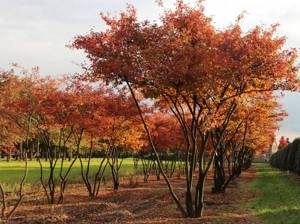
Serviceberry Blood-red The species Blood-red serviceberry is a shrub up to 3 m in height. The species is classified as late-ripening. The berries are small in size. The plant has large, elongated leaves.
Unlike other species, juice can be obtained from the berries of the Blood-red serviceberry. The fruits taste mediocre. The only exception is the Success variety. It has fairly large berries weighing about 0.8 g. They taste sweet and sour.
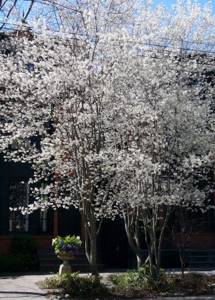
Irga Canadian Suitable for planting in the Moscow region Irga Canadian. This is a fairly tall tree. Sometimes it can reach a height of about 10 m. When the leaves bloom on it, the tree appears silvery. This effect is achieved due to the pubescent leaves. It looks beautiful during flowering. In this case, white inflorescences are formed.
Irga Canadian is a frost-resistant plant, but during prolonged frosts it can freeze. The fruits of this species are large and tasty. The most popular varieties:
- Traditional;
- Parkhill;
- Meeting;
- Honey-wood.
Note! The Canadian serviceberry plant attracts birds that like to peck the berries. That is why you need to take action and drive away unwanted guests.
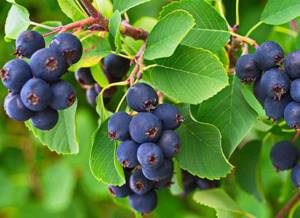
Here the shrub grows up to 3-4 m. Flowering occurs at the end of spring. The fruits weigh up to 2 g. The harvest of serviceberry alder can be harvested up to 2 times. The most famous varieties of serviceberry:
- Smokey;
- Mandan;
- Forestburg.
Rooting shadberry cuttings, cultivation and care
We select cuttings in late autumn, among well-developed shoots of the current year. We make the lower cut even so that later a so-called heel is formed, from which the roots of a new seedling will grow. Between the cuts we leave 3 - 4 healthy buds, making the upper cut oblique.
It is advisable to treat the heel with a phytohormone - Kornevin, or its analogues. Simply powder the lower cut with a dry preparation, or dip it into the solution by 1 cm. The treatment reduces the likelihood of rotting, stimulates active root growth and the survival of cuttings after transplantation.
- For shadberry cuttings you need to prepare a small bed, preferably in partial shade.
- The soil should be fairly loose; good drainage is important for young seedlings.
- Then we dig a groove 20 cm deep.
- Pour 5 cm of sand and peat mixture.
- We place the prepared cuttings vertically, at a distance of 15 - 20 cm from each other.
- We fill the ditch with the prepared mixture of chernozem and compost, in several stages, lightly compacting each layer.
- After this, you need to water it abundantly and then sprinkle the planting with mulch.
- Over the course of a year, the serviceberry seedlings will get stronger, and next fall they can be transplanted to a permanent location.
Root shoots for propagation
How irga reproduces by root shoots:
- dig up last year’s shoot, 0.5 cm thick (at least) and 10 cm long, with a developed root system;
- prepare the holes and plant them vertically to a depth of 5-7 cm in moist soil;
- The soil around the sprouts is moistened at regular intervals.
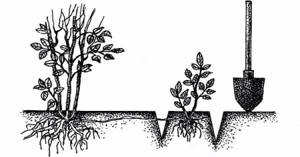
Etiolated shoots for propagation
When propagating irgi, etiolated (bleached) shoots are often used to speed up root formation. Tissue etiolation occurs during shoot development in the absence of light. The mother shoots are planted in a row every 30-50 cm. Next year, the shoots are trimmed to soil level in early spring or late autumn (during the dormant period) and covered with black film. The plant is kept under the film for 4-6 weeks until new shoots 10 cm high appear. To ventilate the plant, the film is secured to arched wire structures to form an awning (tunnel). Then tubes with a diameter of up to 5 cm or bamboo sticks are inserted into the tunnel.
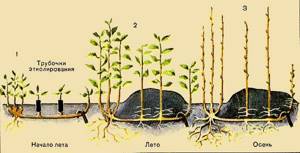
Then the covering film should be cut on the north side in the form of triangular windows to provide access to light, the production of chlorophyll and the acquisition of green color by the tips of the shoots. In this case, direct sunlight should not fall directly on etiolated sprouts. This method is reminiscent of propagation using vertical layering. After 8 days, cuttings are prepared and the film cover is removed so that the plants do not die from the heat.
Choosing a place for Canadian shadberry, planting a young bush and care
Having decided on a variety, or having obtained a simple seedling from gardening friends, we begin planting.
The choice of soil for growing irgi does not matter; the only requirement is the absence of nearby groundwater. The unpretentious shrub thrives on sandy loam soils and loam. But when planted on swampy soils it will not grow.
The place should be spacious enough (2 - 3 sq.m.) so that the bush can grow freely. The Canadian irga prefers to be planted in a sunny place, then further care for it will not require any special expenses. Fruiting will be stable and generous.
plant and care for young serviceberry bushes in the fall.
- First, let's prepare a hole measuring 0.6 m by 0.6 m and 0.5 m deep.
- At the bottom of the pit you need to add a couple of buckets of humus, add fertilizer: superphosphate - 400 g, potassium sulfate - 200 g.
- We place the irgi seedling in the hole and straighten the roots.
- We fill it with a mixture of black soil, sand and compost in equal proportions.
- Then water generously.
- Mulch the sagging root circle with humus or peat.
- We trim the bush at a height of 20 cm - there should be 4 buds left on the shoots.
Varietal shadberry, or forest shadberry, planting and care will not differ fundamentally.
Modern serviceberry is unpretentious, lives and bears fruit for more than 60 years, and therefore enjoys well-deserved recognition from gardeners.
Reproduction of irgi by layering

To begin with, you should choose two-year-old branches with powerful growths or developed annual stems. Experts advise digging in layering in the spring, immediately after the soil has warmed up well. The top layer of soil must be dug up, fertilized and leveled. After this, grooves are made in the soil into which the shoots you have selected are placed, keeping in mind that they should grow as close to the soil surface as possible. After the shoots are fixed in the grooves, it is necessary to pinch their tops. After the height of the young shoots grown from the buds reaches 10 to 12 centimeters, they will need to be half covered with nutritious soil or humus. After 15–20 days, the height of the shoots will already reach 20–27 centimeters, and they will need to be filled halfway with soil again. Separation of rooted cuttings and transplanting them to a new permanent place can be done in the fall or next spring.
Pruning irgi, growing and caring for an adult plant
Recommendations for growing serviceberry do not differ from the traditional rules for growing fruit bushes, but there is less hassle.
- No chemical pest control required.
- There is no need to cover the bushes; the plant easily tolerates frost.
- In the future, you will only need to carry out traditional pruning for shrubs and apply fertilizers.
- A mature shadberry plant should be fed at the beginning of summer with a 10% solution of chicken manure - up to 5 liters. under a bush
The optimal height for an adult plant is up to 2.5 meters, which makes harvesting more convenient.
Spring pruning of irgi must be carried out from the age of 4 years. We thin out the bush, remove weak and dried branches; shorten shoots that are too tall. We treat each cut point with garden varnish. To form a healthy bush, it is enough to leave 15 strong skeletal branches. Watering - when you remember, drought is not a problem.
As for the downsides, irga will require attention and care of the root shoots. It will have to be removed regularly so that the bush maintains its beautiful shape.
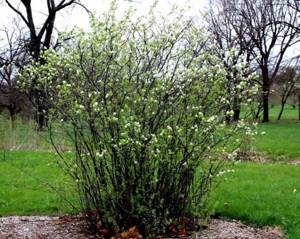
Reproduction of irgi by seeds
Take well-ripened fruits and remove the seeds from them. They are sown immediately after collection directly into open soil. To do this, you need to prepare the beds, fertilize them well; you need to bury the seeds into the ground only 20 mm. Crops need abundant watering, then they are covered with a layer of mulch (dried leaves or straw). Over the winter, the seeds will be able to undergo natural stratification, and seedlings will appear in the spring. If seedlings appear in the autumn, then there is nothing to worry about. In spring, seedlings should be planted so that they are not crowded. During the summer period, they will need to be looked after; provide them with timely watering, weeding and fertilizing with nitrogen-containing fertilizers. At the end of the first year, the height of the seedlings will be only 10-12 centimeters, and the second - from 0.4 to 0.5 meters. Transplanting seedlings to a permanent place can be done only in the third year, when they become stronger.
Irga in landscape design
In its native lands, there are industrial plantings of Canadian serviceberry as a berry plant. In the vastness of Russia, as in Europe, serviceberry was much more often used as a park crop. Beauty and rapid growth, bright coloring - these qualities of serviceberry will be appreciated by those gardeners who were initially only interested in valuable fruits.
Natural shrub serviceberry looks great in an open lawn. In this case, the problem of root growth will be solved using a lawn mower or a regular scythe. Let’s immediately make a reservation that you should not plant shadberry around a tiled seating area, or along garden paths.
The berries contain a large amount of pigment, so they will leave sloppy blots on the stone. Using shrubs, you can form a decorative fence around the site, or cover an existing fence.
If desired, you can form a garden sculpture from a four-year-old bush - a cube, a column, a ball. Tolerance to pruning allows complete creative freedom to create interesting decorative forms. The mini tree is perfect for the background backdrop of a prefabricated flower garden separating the recreation area and the vegetable garden.
Reproduction of irgi by dividing the bush
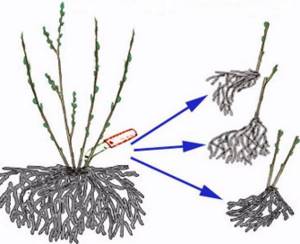
It is advisable to propagate by dividing the irgu bush only if you are transplanting an adult bush. This procedure is recommended to be carried out at the beginning of the spring before the buds swell, as well as in the autumn 4 weeks before the first frost. The old branches of the dug-out shrub need to be cut off and the soil removed from the roots. Then the rhizome is cut into several parts. It should be taken into account that the division must have at least two healthy strong shoots, as well as a developed root system. It is recommended to cut out the old roots and trim the remaining ones. Then the divisions are planted in new places.
Properties of Canadian serviceberry berries - benefits or harm
Irga is worth the effort spent on its cultivation and further care. In addition to being spectacularly decorative, it has a lot of healing properties.
The berries contain pectin and carotene. Tannins, vitamin C, and a rare natural antioxidant - vitamin P. The beneficial properties of serviceberry are not limited to the presence of traditional vitamins.
Irga lowers blood pressure, promotes digestion, and normalizes sleep.
Eating fresh serviceberry berries will help lower blood cholesterol levels. Jam is great for sore throats and colds.
There are also disadvantages to berries. Drivers need to take the sedative effect into account - you shouldn’t get behind the wheel after eating too much shadberry at your favorite dacha. People suffering from diabetes and hemophilia should not abuse this berry. Ripe berries are very sweet, in addition, serviceberry thins the blood.
Winter preparations and storage
This is a fairly fruitful, tasty berry. The bunch does not ripen at the same time, so the berries can be picked as needed, which is very convenient.
The jam is prepared in a classic five-minute manner. But you can add less sugar than usual: only 300 g per 1 kg. berries, since the shadberry itself is very sweet. It goes well with sour berries and fruits, thanks to which you can create interesting mixes with cherry plum, apricots, and apples. The preparations can be varied: irga is easily dried in the sun, and it produces delicious wine. When frozen, the berries do not lose their shape and retain their taste.
